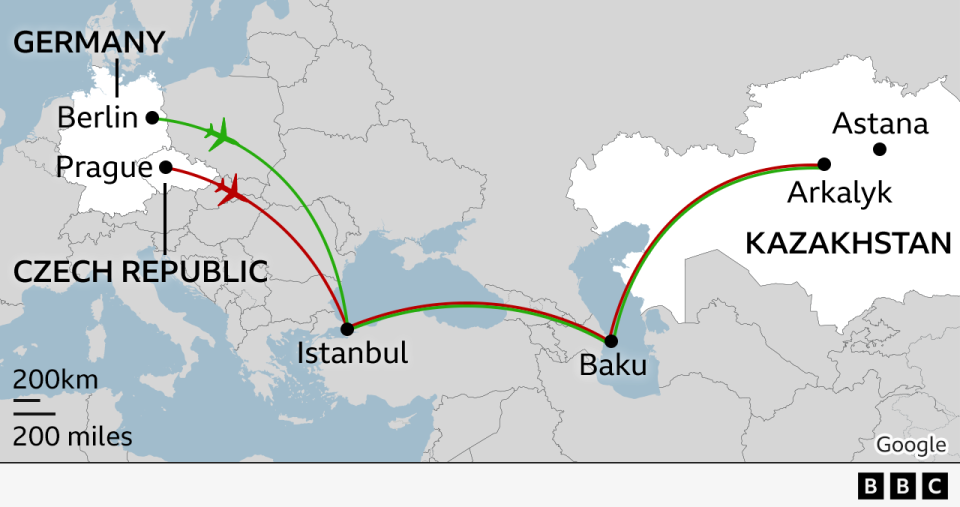Wild horses return to Kazakh plain after centuries
Endangered wild horses have returned to the Golden Steppe of Kazakhstan for the first time in at least 200 years after decades-long efforts.
The airlifts of seven Przewalski's Horses from Europe to the Central Asian country took place in early June in an operation run by Prague Zoo.
Researchers told the BBC that the horses are already doing well two weeks in: roaming around the plains and even beginning the mating process.
Zoo officials say it's a triumph of generations of conservation work.
"This is an endangered species returning to their ancestral lands, a species which went extinct in the wild in the 1960s, last seen in Mongolia...so it's just marvellous... a miracle," said Filip Mašek, a spokesman for Prague Zoo.
While the horses have been slowly reintroduced to Mongolia and China in recent decades, this operation marks the first time they are back in Kazakhstan.
The Przewalski's Horse is the last wild horse species on the planet, named after Russian explorer Nikolai Przewalski who was the first to identify the horse for the European science community.
The species originated millennia ago from the steppes of Central Asia and was taken by researchers to Europe and North America in the 19th and 20th Centuries, where populations were established in zoos.
Some of them ended up in zoos in Munich and Prague - it's their descendants that have now been reintroduced in Kazakhstan.
Cultural artefacts show people in the country's north were riding and using the horses for food at least 2,000 years before records of domesticated horses in Europe.
But by the time of Przewalski's "discovery" in 1879, the horses could only be found in a small section of western Mongolia. Competition with humans and livestock, along with changes in the environment led to them dying out.
Recognising the threat, international efforts were made after World War Two to save the animals. Prague Zoo was entrusted with the "international studship" of the breed.
It introduced the first contingent back into Kazakhstan last week- a group consisting of one stallion and six mares. It aims to bring in at least 40 more over the next five years.
"This is an event of historical import," said the zoo's director Miroslav Bobek in a statement.
"The seven horses that we transported here by two Czech Army planes represent the first individuals of this species in central Kazakhstan in hundreds of years."
Przewalski's horse has long been considered the one true remaining wild horse species- as species such as the American mustang and Australian brumby are feral horses descended from domesticated animals.
The Przewalski's horse is shorter and stockier than modern domesticated horses and their genetic differences show that neither species are ancestors of the other.
Prague Zoo, which has spent the past decade and a half introducing the horses back to Central Asia, mainly in Mongolia, said the Kazakhstan operations had been in the plans since 2022 after signing a deal with the local government.
Last week saw the culmination of years of work. Prague Zoo selected horses from different programmes around Europe and put them together in the same zoo in Berlin - Tierpark Berlin - for several months to become acquainted before their journey.
That then kicked off in early June, with military aeroplanes flying the standing horses in two groups on a 6,000km-route that included stopovers in Turkey and Azerbaijan.

Once they touched ground at the Arkalyk Airport in Kazakhstan, they were taken on an eight-hour drive to the plains where they were then finally released onto the Altyn Dala - the Kazakh name for the Golden Steppe.
“[The mare named] Tessa was the first to run out of the transport box into the pen, then Wespe, followed by Umbra, and Sary brought the foursome to a close," Mr Bobek said.
On Thursday, zoo spokesman Mr Mašek told the BBC that the horses, after some initial trepidation, had begun to venture further afield.
In a "very good" development, scientists this week also reported that some of the horses had begun to mate.
The group has been moved in early summer so they have time to adapt before winter, which is typically brutal on the plains. They will be kept to a 60 hectare "acclimatisation" pen for the first year before being released into the wider grasslands.
Mr Mašek said the zoo hoped to emulate the success of its Mongolia programme last decade - where the introduction of 34 horses had helped boost the native population to now well over 850 animals.
Researchers are optimistic and hopeful, he said. He noted while human activity wasn't the sole reason for the horse's extinction, actions like hunting and breeding the species with domesticated horses accelerated their disappearance.
"We are still responsible the fact this wild horse disappeared and now we can sort of reverse that, and give it back to nature."
He described it as the ultimate goal of a modern zoo: "To sort of be these Noah's Arks which have all these endangered species.
"If it's possible- and sometimes it's not - we should try and do everything to return them to their original environments."
Sign up for our Future Earth newsletter to get exclusive insight on the latest climate and environment news from the BBC's Climate Editor Justin Rowlatt, delivered to your inbox every week. Outside the UK? Sign up to our international newsletter here.



